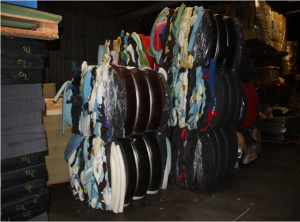We’ll Take Your Old Foam and Replace it With New, But Where Does it Go, Once We Take it From You?
One of the most popular offerings from The Foam Factory is our same-day custom-cut cushion service. If you bring in your worn-out cushions, we can cut your new foam inserts while you wait, or, you can drop them off and pick them up later. It’s a fast, affordable, and hassle-free way to extend the life of your furniture and get more bang for your buck.
Of course, that leaves somebody with the old foam inserts. From time to time, customers will want their old cushions back for a DIY project or something similar. But the majority of the time, customers don’t want or need their old cushions. And when that’s the case, it certainly wouldn’t be very good customer service to demand they take their old foam back!
Given the volume of old cushions that The Foam Factory receives, many customers end up asking us, “What happens to our old foam?”
Let us explain!
To begin with, considering the health and sanitation issues used foam products present, The Foam Factory does not re-sell, re-shape, or re-use any used foam customers leave us with. Every product we stock and sell is brand-new, unused foam. And even if, hypothetically speaking, there were no hygiene and health issues to be concerned with, older foam is going to be worn and inconsistent, so it wouldn’t make sense to use it again anyway.
The other thing we do not do with old foam is throw it in the garbage. One of foam’s most interesting characteristics is how versatile it is when it comes to repurposing. There is a sort of trickle-down effect with foam, where each piece of material that isn’t used on one project can be used for the next. A mattress’ excess foam becomes a pillow. A pillow’s excess foam becomes desk padding. Scraps from a wrist cushion become shredded pet bed filling. There’s always one more way a brand-new piece of polyurethane foam can be used. Granted, the old cushions we receive are brand-new no longer, but even for used materials, there are ways for companies to make something, keeping them out of dumps and landfills.
If that’s the case then – that The Foam Factory doesn’t re-use old foam and they don’t trash it – what do we do with it anyway?
There is a long and a short answer. The quick one is that we compress all old foam, and sell it to industrial foam manufacturers. The longer answer – how we actually do that – is much more interesting!
When a customer leaves us with their old cushions, we collect and deliver them to a special piece of compression machinery – the baler. The baler only performs one task, but what it does do, it does incredibly efficiently. Those old cushions, along with odd scraps, get loaded into the baler, which exerts 54 tons of downward pressure on the foam. The machine squeezes and is refilled until the baler bay is full of foam that can’t be packed much tighter. And given that plate presses with the same force as nine elephants standing on it, the baler can pack foam pretty tightly.
After the baler is full, the compressed foam is removed from the machine, weighing anywhere between 1,000 and 1,500 pounds. Bales of foam, seen above, represent about 15 to 20 percent of the original mass of the compressed materials. A bale of foam, without strapping it down as is normally done, would eventually return to a fairly large percentage of its original size, which attests to the resilience of foam materials, even under forces that great. The bales are strapped together with seatbelt-type lashings that are strong enough to not stretch or snap, and wide enough to keep the force of the foam from causing the band to cut into the material.
After being bound, these bales are then sold to manufacturers, specifically ones that produce specialty bonded foam products. Companies receive these bulk bricks, and through a process that varies company to company, shred the foam, then bond it with heat and adhesive to create a supremely dense and strong product called rebond, or rebonded foam.
Most commonly used as carpet underlayment and floor padding, rebond foam is incredibly strong and dense, especially when compared to the sheets of standard open-cell foam it is built from. Rebond foam is also popular for sound deadening purposes, and some individuals even use it in seating, when the maximum amount of support is desired.
With this process, foam’s life cycle continues. In fact, you may even be walking on the foam you once sat on. Pretty cool, huh?
Tags: New Foam, Old Foam, Rebond
Posted in Announcements



Leave a Reply